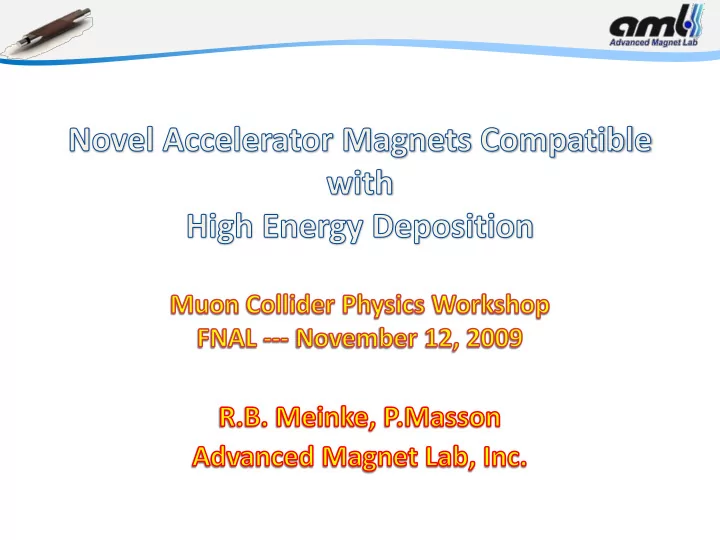

DOUBLE-HELIX TM (DH) COIL CONFIGURATIONS Dipole Quadrupole Trans ansvers rse ma magneti tic c fie ields: lds: Generated by “modulated” solen lenoid win inding ng patter terns ns 2
Unique Properties of DH Coil Configurations Pure multipole fields without field shaping spacers Small systematic field errors Precise conductor placement in machined support grooves Small random field errors Accommodates different conductor forms Wire, cable, tape, mini CICC Bent coils with pure multipole order Multipole fields introduced by bend can be compensated Combined Function Magnets Almost any combination of MP fields possible 3
Properties of DH Coil Configurations Placement of conductor in V-shaped grooves Enables adhesive free coils Highly efficient cooling similar to CICC Mechanical robust solenoid-like winding configuration Excellent quench performance Intrinsically large bending radii Facilitating use of brittle conductors (Nb 3 Sn, HTS) High electrical breakdown strength High reliability No magnet specific tooling required Cost-effective manufacturing process One of a kind magnets with little or no cost penalty 4
Field Uniformity in DH Coils B3; I = 100.00 [A]; @ Rref = 33.33 [mm] 800 600 B3-Coefficients in Units of e-4 Higher order MP fields highly suppressed 400 Without any optimization 200 X: 3.318 Y: -0.01784 0 -200 B5; I = 100.00 [A]; @ Rref = 33.33 [mm] < 0.02 units 150 -400 B5-Coefficients in Units of e-4 -600 100 -800 -400 -300 -200 -100 0 100 200 300 400 50 Position along Axis [mm] X: -3.318 Y: 3.922e-006 0 Integrated MP fields over coil ends -50 Automatically ≈ zero < 0.04 units -100 -150 -400 -300 -200 -100 0 100 200 300 400 Position along Axis [mm] 5
Field Uniformity in Bent DH Coils A3, B3; I = 1500.00 [A]; @ Rref = 36.21 [mm] MP fields calculated along bent axis 600 A3, B3-Coefficients in Units of e-4 400 200 X: -7.958e-013 Y: -0.001325 0 A3, B3; I = 1500.00 [A]; @ Rref = 36.21 [mm] 600 -200 A3, B3-Coefficients in Units of e-4 400 -400 200 -600 -400 -300 -200 -100 0 100 200 300 400 X: -7.958e-013 Position along Bent Axis [mm] Y: 20.81 0 -200 Sextupole of 20.8 units introduced -400 to compensate for iron yoke effect -600 -400 -300 -200 -100 0 100 200 300 400 Position along Bent Axis [mm] 6
Quench Performance of DH Coils Test coil to qualify coil cross-section of bent dipole Nominal Field without yoke 3.5 Tesla With yoke 4.5 Tesla Quench Performance 6000 Decreased temperature to verify that coil 5000 is limited by conductor performance Quench Current 4000 3000 Low helium level in cryostat 2000 1000 0 0 5 10 15 20 Quench Number 7
Manufacturing of Bent Coil Manufacturing of Bent Coil Iron Yoke Assembly 8
DH Technology Accommodates Many Conductor Forms • Standard wire No insulation required • Round mini cable 6-aound-1, 15-strands --- fully transposed • Square mini cable Increase engineering current density • HTS tape conductor YBCO, MgB2 • Cable-in-Conduit Conductor Mini CICC (see Presentation by S. Pourrahimi)` Nb 3 Sn conductor for wind-and-react HTS conductor for applications requiring high temperature margin 9
Losses versus Frequency in AC Operation Parameter Unit Value Frequency SC Current Density A/mm 2 1000 10 Hz 60 Hz Cu to Non-Cu Ratio -- 0.33 Strand Diameter mm 0.18 Magnetization Losses [W] 3.90 23.3 Filament Diameter m 1.00 Eddy Current Losses [W] 0.36 13.0 Twist Pitch mm 5.0 Coupling Losses [W] 28.60 1030 Eff. Matrix Resistivity Ohm*m 1.0E-08 TOTAL Losses [W] 32.86 1066.3 Number of Strands 18 Coupling losses, due to matrix resistivity are dominant Using a miniature CICC in a DH configuration enables operation at 10 Hz and above 10
Adhesive-Free Coils --- Intrinsic CICC 2 kG dipole magnets, AC excitation ≤ 1kHz, Field uniformity < 1×10 -3 Highly cooling efficiency by direct contact of LN2 with conductors HTS conductors in V-shaped grooves would offer unprecedented quench energy margin 11
Bent – Combined Function Magnets Bent dipole magnet with compensated quadrupole Combined function magnet – quadrupole with superimposed dipole 12
Direct Double- Helix™ Technology • Resistive magnets with unprecedented current density Current densities well above 100 A/mm 2 possible approaching performance of SC Great potential for new nano materials Double- Helix™ Grooves in composite for precise conductor placement Direct Double- Helix™ Create conductor and coil in-situ from “arbitrary” materials 13
Key Features of DDH Technology Field generating current path machined out of conductive cylinders • Complete control over conductor cross section along its path • Constraints caused by wire manufacturing eliminated • Very high cooling efficiency with insignificant thermal gradients • Current densities in excess of 100 A/mm 2 in DC operation of normal • conductors achieved High field uniformity due to Double-Helix TM winding configuration • Magnets with arbitrary multipole order and combined function • Highly cost-effective since no magnet-specific tooling is needed • Unprecedented miniaturization of coils feasible • High radiation hardness based on metals and ceramic materials • 14
Horizontal and vertical Steering Magnet Concentric DDH Coils Magnet Assembly 0.1 Tesla (operates in 9Tesla background field) Beam aperture: 20 mm Magnet OD: 40 mm 15
Temperature and Current Density Distribution in DDH Windings High current density Conduct heat to large X-section area Temperature Distribution along 1 turn Current density distribution 16
Summary Double-Helix and Direct-Double-Helix Technology enables unprecedented performance in respect to energy deposition. The technology accommodates advanced conductors that offer large energy margins due to AC losses and energy deposition. CIC conductors --well qualified in fusion magnets -- become available for accelerator magnets. The DH and DDH technology offers small systematic field errors without complex field forming spacers. The unique manufacturing process of DH and DDH coils enables cost effective manufacturing and rapid prototyping. 17
Recommend
More recommend